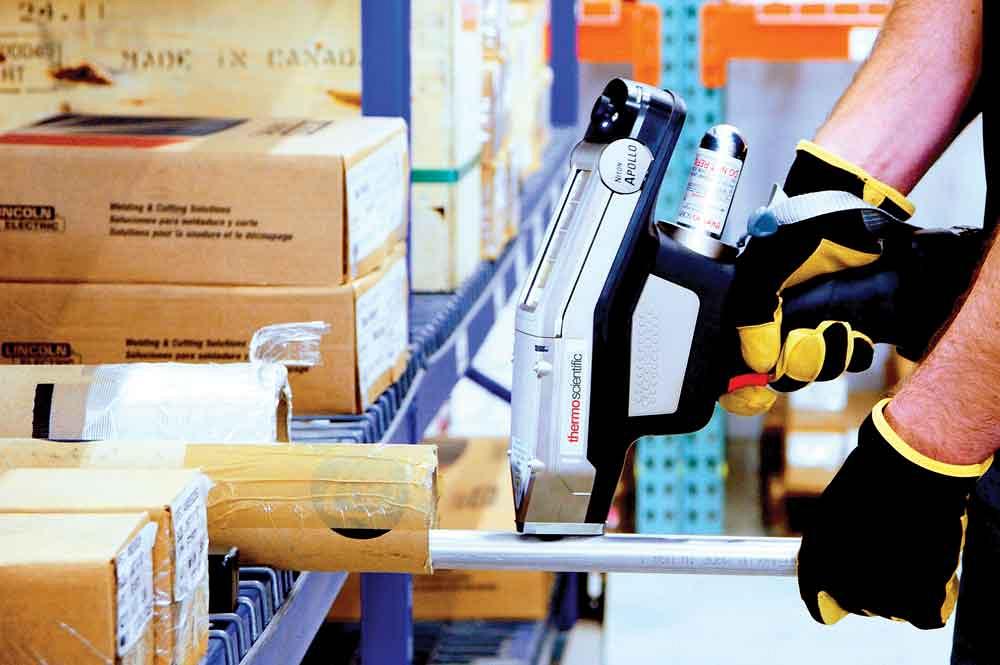Technical Sales Manager
- FMA
- The Fabricator
- FABTECH
- Canadian Metalworking
Categories
- Additive Manufacturing
- Aluminum Welding
- Arc Welding
- Assembly and Joining
- Automation and Robotics
- Bending and Forming
- Consumables
- Cutting and Weld Prep
- Electric Vehicles
- En Español
- Finishing
- Hydroforming
- Laser Cutting
- Laser Welding
- Machining
- Manufacturing Software
- Materials Handling
- Metals/Materials
- Oxyfuel Cutting
- Plasma Cutting
- Power Tools
- Punching and Other Holemaking
- Roll Forming
- Safety
- Sawing
- Shearing
- Shop Management
- Testing and Measuring
- Tube and Pipe Fabrication
- Tube and Pipe Production
- Waterjet Cutting
Industry Directory
Webcasts
Podcasts
FAB 40
Advertise
Subscribe
Account Login
Search
Understanding the latest alloy-verification technologies for tube and pipe production, fabrication
Modern metal ID technologies help manufacturers comply with material specifications, mitigate risk
- By James Stachowiak
- March 20, 2020
- Article
- Shop Management

Even when a tube and pipe producer or fabricator gets its material from a trusted source, metal alloy verification using technologies like LIBS, OES, and XRF is a good idea to prevent material mixups. Image provided by Thermo Fisher Scientific
Advances in technology make many tools smaller, faster, and easier to use, and the same can now be said for material identification instruments used in tube and pipe production and fabrication. Mobile optical emission spectroscopy (OES), hand-held X-ray fluorescence (XRF), and hand-held laser-induced breakdown spectroscopy (LIBS) are all examples of portable instruments equipped with the power to conduct laboratory-grade analysis in the field. Portable elemental analyzers allow users to test materials in the shop in a matter of seconds to determine their elemental makeup, verifying that the metal used in production meets required specifications.
Positive material identification (PMI) capability helps mitigate risk and improve productivity, but it can be difficult to determine which one of these three analytical techniques is best for tube and pipe producers and fabricators. An overview on how OES, XRF, and LIBS work, and the benefits they provide to tube and pipe manufacturers, can go a long way in helping to make a solid equipment investment.
How They Work
A nondestructive test, XRF irradiates the sample under test with high-energy X-rays produced by a miniaturized X-ray tube in the instrument. This causes atoms in the sample to emit secondary (or fluorescent) X-rays that are unique to the elements present in the sample. The instrument detector measures and analyzes these characteristic secondary X-rays to determine their chemical identity and their concentration in the metal being tested. This capability makes XRF useful for both qualitative and quantitative analysis of material composition.
Rather than emitting X-rays like an XRF analyzer, OES instruments send a high-voltage electrical pulse to excite atoms in a sample. The sample then discharges an arc spark that can be measured and analyzed by a spectrometer in the OES unit. From there, the OES system determines the chemical composition of the sample being tested.
LIBS analyzers ablate the surface of the sample with a highly focused laser, which produces a plasma composed of electronically excited atoms and ions. These atoms begin to decay to their ground states and emit wavelengths of light, unique to each element, that are analyzed by a spectrometer in the LIBS device. As with XRF, LIBS analysis can be used for both quantitative and qualitative measurements.
Of the three, XRF is the only one categorized as nondestructive; OES and LIBS are minimally destructive in that they leave a minute burn mark on the sample.
Productivity Considerations
Considerations to keep in mind when choosing an elemental analyzer include portability, measurement speed, and ease of use.
Portability can have a substantial impact on productivity. Both LIBS and XRF are available in the form of lightweight, hand-held analyzers, with some LIBS units weighing as little as 6 pounds. This means analysis can be conducted anywhere in the plant or warehouse, as well as in difficult-to-reach areas in the field. A mobile OES can weigh up to 80 pounds and requires a pushcart.
Factors that contribute to speed and ease of use include:
• Sample Preparation - Both mobile OES and LIBS generally require sample preparation because even trace amounts of contaminants such as grease, paint, and oxidation can lead to unreliable results. Sample preparation involves cleaning and grinding a square inch of testing area on the metal. XRF rarely requires sample preparation.
• Instrument Setup - XRF is a point-and-shoot technology that doesn’t require daily setup. LIBS daily setup is relatively minimal, requiring a two-step process that takes about 10 minutes. Daily setup of OES requires several steps and 15 to 20 minutes to complete, and both instruments require regular cleaning.
• Analysis Speed - Depending on the material being tested, advanced LIBS and OES analyzers can test most samples in about 10 seconds. This includes material in which carbon content is of interest. An XRF analyzer, for most materials, can identify and provide the chemistry of many alloy types in 3 to 5 seconds. However, this does not include carbon analysis, and the analysis time can increase slightly if other light elements are present in the alloy. A few seconds might not seem like much time, but seconds add up quickly in situations that might require several averaged readings, or when several samples are to be analyzed. Therefore, choosing the right technology is important for any application in which higher throughput is the goal.
Material Considerations
Tube and pipe producers and fabricators should consider more than just productivity when choosing an elemental analyzer. The three technologies differ in their analytical capabilities, so it’s important to match the capabilities to the materials to be tested.
LIBS and OES are both useful for differentiating between alloys and quantifying carbon concentrations in low-alloy steels, carbon steels, and stainless steels. This includes the low-carbon content of L-grade stainless steels.
XRF provides quick chemistry and grade verification of incoming raw materials and final products, and it can be used for compositional analysis and to measure the thickness of alloy coatings. In the case of steel tubes, for example, a coating may be applied to prevent oxidation during storage and transportation or to ease the application of paint. The ability to analyze layers of coating helps ensure quality control and reduce coating waste.
Often, both XRF and LIBS may be required to conduct thorough quality control of final products. These complementary devices can be used throughout the production process, from testing incoming materials to outgoing quality assurance or quality control on finished tubes, pipes, and assemblies.
Trust but Verify
As the industry continues to globalize, many tube and pipe producers and fabricators are increasingly purchasing material from overseas, and these might include new vendors they have not worked with previously. Unfortunately, material test reports might not always be accurate, so a trust-but-verify approach is necessary to confirm the makeup of the material the supplier sends. This is where analytical technology comes into play.
Inexperienced or unreliable suppliers might attempt to cut costs by not performing PMI in-house, or they might fail to use an outside testing lab to verify the material they ship. The consequences of a material mixup can range from rejection by the end user to a catastrophic failure that could result in injury or even death. For example, using a subpar material in a critical application, such as an aircraft engine, places the safety of everyone onboard at risk. By doing due diligence in performing PMI onsite, tube and pipe producers and fabricators can go a long way in protecting their reputations and businesses. Using elemental analysis to catch problems early prevents the costly problem of determining that goods have been developed out of specification after adding value during the production process. Oftentimes, the resulting fabricated part or assembly must be scrapped entirely.
Material verification doesn’t stop at incoming inspection. Supervisors and quality control managers must ensure that the correct materials are used throughout the production process, so best practice requires PMI at each stage of production. The utmost compliance uses a protocol of testing that follows the part, assembly, or equipment all the way through the production process to a final validation.
For critical components, a PMI should be the first step when the shipment is received, and inspections should continue right up to the point of installation. For installations that predate the inspection process (for example, a 30-year-old refinery), performing a thorough validation may require a shutdown to verify the integrity of components and assemblies that did not undergo adequate testing before they were installed. Comprehensive use of PMI technology today can prevent such a drastic step in the future.
James Stachowiak is technical sales manager for Thermo Fisher Scientific, 168 Third Ave., Waltham, MA 02451, 800-678-5599.
About the Author
subscribe now

The Fabricator is North America's leading magazine for the metal forming and fabricating industry. The magazine delivers the news, technical articles, and case histories that enable fabricators to do their jobs more efficiently. The Fabricator has served the industry since 1970.
start your free subscription- Stay connected from anywhere

Easily access valuable industry resources now with full access to the digital edition of The Fabricator.

Easily access valuable industry resources now with full access to the digital edition of The Welder.

Easily access valuable industry resources now with full access to the digital edition of The Tube and Pipe Journal.
- Podcasting
- Podcast:
- The Fabricator Podcast
- Published:
- 04/16/2024
- Running Time:
- 63:29
In this episode of The Fabricator Podcast, Caleb Chamberlain, co-founder and CEO of OSH Cut, discusses his company’s...
- Industry Events
16th Annual Safety Conference
- April 30 - May 1, 2024
- Elgin,
Pipe and Tube Conference
- May 21 - 22, 2024
- Omaha, NE
World-Class Roll Forming Workshop
- June 5 - 6, 2024
- Louisville, KY
Advanced Laser Application Workshop
- June 25 - 27, 2024
- Novi, MI































